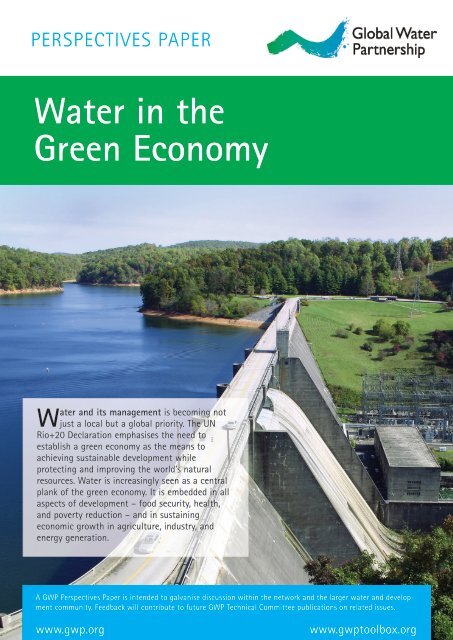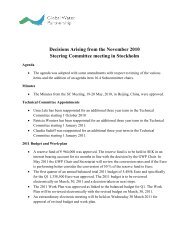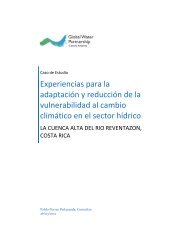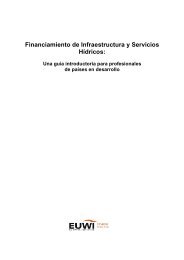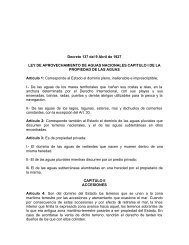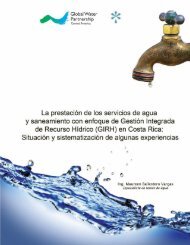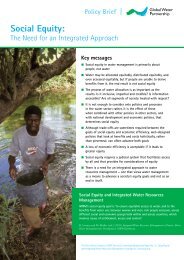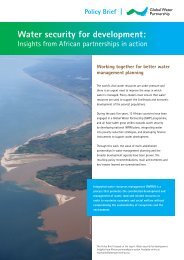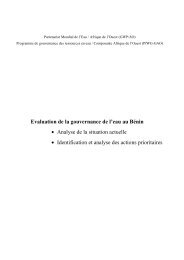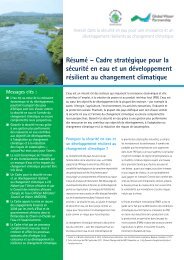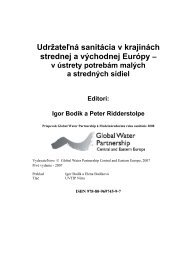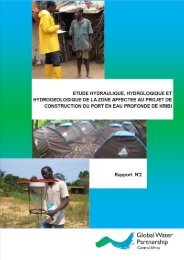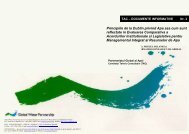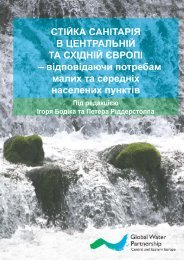Water in the Green Economy - Global Water Partnership
Water in the Green Economy - Global Water Partnership
Water in the Green Economy - Global Water Partnership
Create successful ePaper yourself
Turn your PDF publications into a flip-book with our unique Google optimized e-Paper software.
PERSPECTIVES PAPERThe <strong>Global</strong> <strong>Water</strong> <strong>Partnership</strong>’s vision is for a water secure world. Its mission is to support <strong>the</strong> susta<strong>in</strong>abledevelopment and management of water resources at all levels.GWP is a global network of 13 Regional <strong>Water</strong> <strong>Partnership</strong>s, 80 Country <strong>Water</strong> <strong>Partnership</strong>s and more than2,500 Partner organisations <strong>in</strong> 164 countries.GWP was founded <strong>in</strong> 1996 by <strong>the</strong> World Bank, <strong>the</strong> United Nations Development Programme (UNDP), and <strong>the</strong>Swedish International Development Cooperation Agency (SIDA) to foster <strong>in</strong>tegrated water resource management(IWRM).IWRM is <strong>the</strong> coord<strong>in</strong>ated development and management of water, land and related resources <strong>in</strong> order tomaximise economic and social welfare without compromis<strong>in</strong>g <strong>the</strong> susta<strong>in</strong>ability of eco-systems and <strong>the</strong>environment.The network is open to all organisations <strong>in</strong>volved <strong>in</strong> water resources management: developed and develop<strong>in</strong>gcountry government <strong>in</strong>stitutions, agencies of <strong>the</strong> United Nations, bi- and multi-lateral development banks,professional associations, research <strong>in</strong>stitutions, non-governmental organisations, and <strong>the</strong> private sector.GWP Perspectives Papers are available at <strong>the</strong> GWP IWRM ToolBox: www.gwptoolbox.orgTowards Integrated Urban <strong>Water</strong> Management (2011)Increas<strong>in</strong>g <strong>Water</strong> Security - A Development Imperative (2012)<strong>Water</strong> <strong>in</strong> <strong>the</strong> <strong>Green</strong> <strong>Economy</strong> (2012)©<strong>Global</strong> <strong>Water</strong> <strong>Partnership</strong>, June 2012Portions of <strong>the</strong> text of this publication may be reproduced for educational or non-commercial use without priorpermission from <strong>the</strong> <strong>Global</strong> <strong>Water</strong> <strong>Partnership</strong> (GWP), provided that <strong>the</strong> source is acknowledged, with mention of <strong>the</strong>complete name of <strong>the</strong> report, and that <strong>the</strong> portions are not used <strong>in</strong> a mislead<strong>in</strong>g context. No use of this publicationmay be made for resale or o<strong>the</strong>r commercial purposes without prior written permission of GWP. Op<strong>in</strong>ions expressed<strong>in</strong> this publication do not imply endorsement by GWP.2
<strong>Water</strong> <strong>in</strong> <strong>the</strong> <strong>Green</strong> <strong>Economy</strong>The Stockholm Statement (2011) described water as<strong>the</strong> ‘bloodstream of <strong>the</strong> green economy’. Yet waterresources are limited <strong>in</strong> many parts of <strong>the</strong> world andpressures are <strong>in</strong>creas<strong>in</strong>g as <strong>the</strong> demand for water forpeople, food, <strong>in</strong>dustry and <strong>the</strong> environment grows. If<strong>the</strong> world cont<strong>in</strong>ues to use water at current rates it isestimated that demand could outstrip supply by asmuch as 40% by 2030, putt<strong>in</strong>g both water and foodsecurity at risk, constra<strong>in</strong><strong>in</strong>g susta<strong>in</strong>able economicdevelopment, and degrad<strong>in</strong>g <strong>the</strong> ‘green <strong>in</strong>frastructure’on which everyth<strong>in</strong>g else depends.Momentum is now build<strong>in</strong>g to highlight water andits role <strong>in</strong> <strong>the</strong> green economy as a priority issue forRio+20. In November 2011, world leaders andprofessionals ga<strong>the</strong>red <strong>in</strong> Bonn to prepare for Rio+20and <strong>the</strong>y exam<strong>in</strong>ed water as <strong>the</strong> common threadconnect<strong>in</strong>g food, energy, and climate change. TheBonn conference highlighted that susta<strong>in</strong>abledevelopment and growth beyond poverty eradicationcan be achieved by better management of <strong>the</strong> world’secosystems and a more <strong>in</strong>formed and optimal use ofwater, land, and o<strong>the</strong>r natural resources.We argue that water is not just part of <strong>the</strong> economy;it is embedded with<strong>in</strong> <strong>the</strong> economy. Without it <strong>the</strong>economy could not function. Thus water will becentral to <strong>the</strong> <strong>in</strong>novative th<strong>in</strong>k<strong>in</strong>g and effectivesolutions required to establish <strong>the</strong> green economy. Inthis paper we set out <strong>the</strong> case for an Integrated <strong>Water</strong>Resources Management (IWRM) approach to watersecurity (Box 1) and its potential to lead <strong>the</strong> processof ‘green<strong>in</strong>g’ <strong>the</strong> world’s economies.Shocks and challengesTwenty years on from <strong>the</strong> first Rio Conference <strong>in</strong> 1992– <strong>the</strong> world summit that addressed susta<strong>in</strong>abledevelopment – <strong>the</strong> world is still fac<strong>in</strong>g immensechallenges. Meet<strong>in</strong>g <strong>the</strong> Millennium DevelopmentGoals (MDGs) has been clouded by major issues thathave slowed progress. Over <strong>the</strong> past decade we haveseen <strong>in</strong>creas<strong>in</strong>g globalization, rapid demographicchanges, and <strong>the</strong> cont<strong>in</strong>ued presence of hunger andpoverty, particularly <strong>in</strong> Africa and South Asia, where<strong>the</strong>re is little prospect of meet<strong>in</strong>g <strong>the</strong> MDGs by 2015.The world has also experienced several, and <strong>in</strong> somecases, unexpected shocks.Box 1: GWP’s vision of a water secureworldA water secure world is vital for a better future: afuture <strong>in</strong> which <strong>the</strong>re is enough water for social andeconomic development and for ecosystems. A watersecure world <strong>in</strong>tegrates a concern for <strong>the</strong> <strong>in</strong>tr<strong>in</strong>sicvalue of water toge<strong>the</strong>r with its full range of uses forhuman survival and well-be<strong>in</strong>g. A water secure worldharnesses water's productive power and m<strong>in</strong>imises itsdestructive force. It is a world where every person hasenough safe, affordable water to lead a clean, healthyand productive life. It is a world where communitiesare protected from floods, droughts, landslides,erosion and water-borne diseases. <strong>Water</strong> security alsomeans address<strong>in</strong>g environmental protection and <strong>the</strong>negative effects of poor management, which willbecome more challeng<strong>in</strong>g as climatic variability<strong>in</strong>creases. A water secure world reduces poverty,advances education, and <strong>in</strong>creases liv<strong>in</strong>g standards. Itis a world where <strong>the</strong>re is an improved quality of lifefor all, especially for <strong>the</strong> most vulnerable—usuallywomen and children—who benefit most from goodwater governance.<strong>Global</strong> <strong>Water</strong> <strong>Partnership</strong> (GWP) Strategy 2009-2013These <strong>in</strong>clude:• <strong>the</strong> rise <strong>in</strong> energy prices <strong>in</strong> 2008 and 2010 andconcerns about energy security;• related food and commodity price rises;• worries about water and food security and how tofeed 9 billion people by 2050;• decl<strong>in</strong><strong>in</strong>g ecosystem services; and• <strong>the</strong> global economic recession.Climate change adds ano<strong>the</strong>r level of risk, which maybr<strong>in</strong>g <strong>the</strong> prospect of more extreme and unpredictablefloods and droughts to those parts of <strong>the</strong> world thatare already struggl<strong>in</strong>g to cope with climateuncerta<strong>in</strong>ties.All <strong>the</strong>se shocks and challenges impact bothdevelop<strong>in</strong>g and developed countries and <strong>the</strong>y aretest<strong>in</strong>g <strong>the</strong> optimistic global vision of <strong>in</strong>creas<strong>in</strong>gprosperity and <strong>the</strong> relevance of <strong>the</strong> economic growthmodel accepted by <strong>in</strong>dustrialized societies. There is agrow<strong>in</strong>g realization that <strong>the</strong> earth’s resources are3
PERSPECTIVES PAPERbut it is also a threat because of its destructivepowers which can cause poverty and death throughdroughts and floods, and can cause contam<strong>in</strong>ation,disease, dispute, and conflict. All aspects of productiondepend on water – agriculture, <strong>in</strong>dustry,energy, and transport. Most <strong>in</strong>dustrialised nationshave a legacy of ‘easy hydrology’ – low ra<strong>in</strong>fallvariability and ra<strong>in</strong> distributed throughout <strong>the</strong> yearand perennial rivers susta<strong>in</strong>ed by groundwater baseflows (Grey and Sadoff, 2007). They <strong>in</strong>vested heavily <strong>in</strong>water <strong>in</strong>frastructure, <strong>in</strong>stitutions and managementcapacity to both exploit <strong>the</strong> benefits of water and to<strong>in</strong>sulate society and economic growth aga<strong>in</strong>st water’sdestructive powers.Develop<strong>in</strong>g countries recognise this but lack <strong>the</strong><strong>in</strong>vestment, <strong>in</strong>stitutional structures, and capacity toimprove <strong>the</strong>ir water security. Most have large ruralpopulations that rely on subsistence agriculture andare exposed to <strong>the</strong> vagaries of unpredictable seasonsand also to <strong>the</strong> ‘difficult hydrology’ of absolute waterscarcity and severe flood risk, usually at differenttimes but often <strong>in</strong> <strong>the</strong> same place (Grey and Sadoff,2007). More difficult hydrology usually means morecostly <strong>in</strong>frastructure to control and manage water.<strong>Water</strong> security is <strong>the</strong> ma<strong>in</strong> aim of <strong>in</strong>vestment <strong>in</strong> water.But does <strong>in</strong>vestment <strong>in</strong> water drive growth or doesgrowth drive <strong>in</strong>vestment <strong>in</strong> water? In most caseswater security is a driver of growth and a prerequisitefor bus<strong>in</strong>ess <strong>in</strong>vestment. But <strong>in</strong> some placesgood water management comes as a consequence ofgrowth. Improved water supply and sanitation, forexample, can boost economic growth. Poor countrieswith improved access to clean water enjoy averageannual growth rates of 3.7% whereas countries with<strong>the</strong> same per capita <strong>in</strong>come without access haveaverage growth of only 0.1% (WHO, 2005). What isclear is that water security and growth are symbiotic.The power of Integrated <strong>Water</strong>Resources Management (IWRM)Agenda 21 (agreed at <strong>the</strong> UNCED <strong>in</strong> 1992) explicitlysupports <strong>the</strong> use of natural resources for social equity,economic development, and a susta<strong>in</strong>able environment.Integrated <strong>Water</strong> Resources Management(IWRM) offers a set of pr<strong>in</strong>ciples which help tooperationalize Agenda 21 (Box 4). It addresses keywater related challenges by seek<strong>in</strong>g to balance <strong>the</strong>‘three Es’ – efficiency, to make water resources go asfar as possible; equity <strong>in</strong> allocat<strong>in</strong>g water acrossdifferent social and economic groups; and environmentalsusta<strong>in</strong>ability, to protect <strong>the</strong> water resourcesbase and eco-systems. These pr<strong>in</strong>ciples recognise thatwater is a public good with both social and economicvalues and that good water manage-ment requiresboth a broad holistic perspective and <strong>the</strong> appropriate<strong>in</strong>volvement of users at different levels (Muller andLenton, 2009). The <strong>in</strong>tegrated approach explicitlychallenges conventional, fractional water developmentand management systems and emphasizes morecoord<strong>in</strong>ated decision mak<strong>in</strong>g across sectors and scales.IWRM is not an end <strong>in</strong> itself; ra<strong>the</strong>r, it is a means toachiev<strong>in</strong>g <strong>the</strong> three strategic objectives.6
PERSPECTIVES PAPERhas for many years supported countries to adopt anIWRM approach. The approach is <strong>in</strong>creas<strong>in</strong>gly seen asa pillar of green growth. A fragmented approach willnot lead to green growth. For example, when awatershed is deforested, it is <strong>the</strong> value of <strong>the</strong> timberand <strong>the</strong> cost to harvest that timber that is generallyaccounted for <strong>in</strong> <strong>the</strong> economic analysis and price, not<strong>the</strong> clean water no longer be<strong>in</strong>g produced by <strong>the</strong>watershed or <strong>the</strong> carbon no longer be<strong>in</strong>g sequesteredby <strong>the</strong> trees (UNEP, 2011b). <strong>Water</strong> security cannot beachieved without a more enlightened green growthapproach to economic development. <strong>Water</strong> securityand green growth are synergistic and mutuallyre<strong>in</strong>forc<strong>in</strong>g.to <strong>the</strong> susta<strong>in</strong>able management and use of ecosystemsas <strong>the</strong> ‘green <strong>in</strong>frastructure’ which supports economicgrowth and food and water security, <strong>in</strong>clud<strong>in</strong>gprotection from floods and droughts.Reth<strong>in</strong>k<strong>in</strong>g water storage holistically is essential,whe<strong>the</strong>r through small-scale solutions such asra<strong>in</strong>water harvest<strong>in</strong>g and natural storage, or largescalemanagement of reservoirs, storm-water systemsand aquifers. We can seek solutions <strong>in</strong> time-honouredtraditional ways of safeguard<strong>in</strong>g water as a preciousresource and at <strong>the</strong> same time utilise <strong>the</strong> latesttechnologies of remote sens<strong>in</strong>g and geospatialmapp<strong>in</strong>g to better understand <strong>the</strong> water system.Box 5: Synergies between water security and green growthCharacteristics of green growth• More effective use of natural resources <strong>in</strong> economicgrowth• Valu<strong>in</strong>g eco-systems• Inter-generational economic policies• Increased use of renewable sources of energy• Protection of vital assets from climate relateddisasters• Reduce waste of resources – and f<strong>in</strong>anceCharacteristics of water security• Ensure enough water for social and economicdevelopment• Ensure adequate water for ma<strong>in</strong>ta<strong>in</strong><strong>in</strong>g eco-systems• Susta<strong>in</strong>able water availability for future generations• Balance <strong>the</strong> <strong>in</strong>tr<strong>in</strong>sic value of water with its uses forhuman survival and welfare• Harness productive power of water• M<strong>in</strong>imise <strong>the</strong> destructive power of water• Ma<strong>in</strong>ta<strong>in</strong> water quality and avoid pollution anddegradationIWRM is now well accepted <strong>in</strong> pr<strong>in</strong>ciple but it takestime and skill to apply it <strong>in</strong> practice as it requiresconsiderable coord<strong>in</strong>ation and <strong>in</strong>formation shar<strong>in</strong>gamong multiple sectors and different layers ofauthority. Adm<strong>in</strong>istrations are still structuredpr<strong>in</strong>cipally by economic sectors (as are InternationalF<strong>in</strong>ancial Institutions) whereas water, as a naturalresource, impacts on and is impacted by <strong>the</strong>se sectorsbut often has no <strong>in</strong>stitutional home. <strong>Water</strong> resourcesare thus easily exploited and polluted by users due toits weak management and/or regulation.Manag<strong>in</strong>g water better can provide ‘no regrets’opportunities and solutions to support green growthand build resilience to climate change. The profligateuse of water is common <strong>in</strong> many countries and this iscoupled with low rates of <strong>in</strong>novation and <strong>in</strong>vestment<strong>in</strong> water worldwide. Fortunately, <strong>the</strong>re is tremendousscope for adaptation. This applies to all economicsectors <strong>in</strong>clud<strong>in</strong>g energy, <strong>in</strong>dustry, and agriculture, andRecycl<strong>in</strong>g and reus<strong>in</strong>g both domestic and <strong>in</strong>dustrialwastewater multiplies <strong>the</strong> volume of water availablefor human use, and treat<strong>in</strong>g waste can produceenergy. Agriculture is a key sector where future waterproductivity ga<strong>in</strong>s are essential to achieve greengrowth. S<strong>in</strong>ce agriculture uses <strong>the</strong> lion’s share ofwater <strong>in</strong> many countries (as much as 90% <strong>in</strong> some),<strong>the</strong>se shifts will have benefits across o<strong>the</strong>r sectors –be it environment, energy, domestic waterconsumption, <strong>in</strong>dustry, and flood protection.There is a risk that political attention and fund<strong>in</strong>g willbe targeted entirely at climate mitigation related toenergy issues while neglect<strong>in</strong>g water or o<strong>the</strong>r naturalresources. Of course, <strong>in</strong> many develop<strong>in</strong>g countriesadaptation is <strong>the</strong> prime issue and build<strong>in</strong>g resilienceto climate change is closely l<strong>in</strong>ked to achiev<strong>in</strong>g watersecurity. (AMCOW & GWP, 2012)8
<strong>Water</strong> <strong>in</strong> <strong>the</strong> <strong>Green</strong> <strong>Economy</strong>Manag<strong>in</strong>g <strong>the</strong> transitionA key question is how to best manage <strong>the</strong> transitionto a water secure green economy. It will requireprioritisation as not everyth<strong>in</strong>g can be done at once.Possible actions will need categoris<strong>in</strong>g to optimisesp<strong>in</strong>offs and sequence activities for <strong>the</strong> short,medium, long term. The transition will require:• Policy <strong>in</strong>struments that promotecomplementarities (economic, social,environmental) and leverage change• Fiscal <strong>in</strong>struments that give a price toenvironmental goods• Streng<strong>the</strong>ned <strong>in</strong>stitutional arrangements thatfunction with<strong>in</strong> <strong>in</strong>creas<strong>in</strong>g complexity, cutt<strong>in</strong>gacross sectoral silos and sovereign boundaries• A new generation of f<strong>in</strong>ancial <strong>in</strong>struments thatshare risk between governments and <strong>in</strong>vestors andmake new technology affordable• Skills development that support <strong>the</strong> emerg<strong>in</strong>ggreen sectors <strong>in</strong> <strong>the</strong> economy• Information and monitor<strong>in</strong>g: set targets, def<strong>in</strong>etrajectories and ga<strong>the</strong>r <strong>the</strong> right <strong>in</strong>formation tomonitor progress (e.g., on water/energyefficiencies)• Innovation plann<strong>in</strong>g: <strong>in</strong>creas<strong>in</strong>g water productivity,develop<strong>in</strong>g stress tolerant materials that canaddress water scarcity, sal<strong>in</strong>ization, groundwatercontam<strong>in</strong>ation, as well as water quality andwastewater treatment.The transition to a water secure and green economywill require contextualization and differentiation, andthis will depend on each country’s specific conditions.In <strong>the</strong> richer countries, <strong>the</strong> challenge will be tochange lifestyles and reduce <strong>the</strong> consumption ofnatural resources to susta<strong>in</strong>able levels. In <strong>the</strong>develop<strong>in</strong>g countries, <strong>the</strong> transition will follow adifferent path as <strong>the</strong> challenge will be to stimulateeconomic growth <strong>in</strong> a way that water security and <strong>the</strong>green economy co<strong>in</strong>cide with susta<strong>in</strong>able development.While hunger and poverty prevail, both waterand food security will be high on <strong>the</strong> political agenda.A traditional approach to development through aidthat tries to stimulate production is <strong>in</strong>sufficient, and<strong>in</strong>novative ways of achiev<strong>in</strong>g growth are needed (Box6).9
PERSPECTIVES PAPERBox 6: Achiev<strong>in</strong>g green growth – <strong>the</strong> roleof food securityIn sub-Saharan Africa, where more than 80% of<strong>the</strong> population are smallholder farmers, with fewexceptions all <strong>the</strong> effort and <strong>in</strong>vestment bygovernments and development agencies over <strong>the</strong>past 50 years have failed to improve productivityand stimulate growth <strong>in</strong> agriculture. Attentionhas focused on improv<strong>in</strong>g seed varieties, us<strong>in</strong>gfertilizers, and build<strong>in</strong>g agricultural extensionservices and on restor<strong>in</strong>g water and ecosystemsto reverse anthropogenic damage. But farmersrarely adopt productivity enhanc<strong>in</strong>g technologieswhen <strong>the</strong> l<strong>in</strong>ks to cash markets are poor. So <strong>the</strong>reare few <strong>in</strong>centives to grow more than householdneeds and <strong>in</strong> such circumstances people becometrapped <strong>in</strong> subsistence farm<strong>in</strong>g and <strong>in</strong> poverty.Push<strong>in</strong>g productivity is necessary but notsufficient. It is equally important to considerhow to deal with crops once <strong>the</strong>y are harvested;how to develop agricultural value cha<strong>in</strong>s whichl<strong>in</strong>k farmers and consumers; how to improvepostharvest handl<strong>in</strong>g, value addition process<strong>in</strong>g,and develop thriv<strong>in</strong>g and profitable market-drivenfood sectors. These are <strong>the</strong> ‘pull’ factors whichdrive most modern market economies and <strong>in</strong> turndrive productivity and growth. Fewer farmers maybe needed as productivity <strong>in</strong>creases but morepeople will be needed to work along <strong>the</strong> valuecha<strong>in</strong>. So employment shifts from farm<strong>in</strong>g toagriculture <strong>in</strong> its broadest sense. In <strong>the</strong> UK forexample, less than 4% of <strong>the</strong> population work <strong>in</strong>farm<strong>in</strong>g whereas up to 25% work <strong>in</strong> <strong>the</strong> food<strong>in</strong>dustry. The opportunities are <strong>the</strong>re and <strong>the</strong> tw<strong>in</strong>pressures of scarce water resources and agrow<strong>in</strong>g consumer demand for safe, quality foodproducts with sound provenance can provide <strong>the</strong>conditions for both growth and susta<strong>in</strong>abledevelopment – <strong>the</strong> very essence of <strong>the</strong> greeneconomy.Kilimo Trust, 2012River bas<strong>in</strong>s are a natural and logical place for spatialplann<strong>in</strong>g and mak<strong>in</strong>g visible upstream/downstreameffects on resource use. Stimulat<strong>in</strong>g bus<strong>in</strong>ess developmentwill require a trans-discipl<strong>in</strong>ary approach whichbr<strong>in</strong>gs toge<strong>the</strong>r <strong>the</strong> different sectors and stakeholderlevels. By focus<strong>in</strong>g on responsible bus<strong>in</strong>ess developmentthis would encourage ‘river bas<strong>in</strong> developmentand management plann<strong>in</strong>g’ ra<strong>the</strong>r than <strong>the</strong> moretraditional focus on water and ‘river bas<strong>in</strong> managementplann<strong>in</strong>g’. This would br<strong>in</strong>g toge<strong>the</strong>r private<strong>in</strong>vestors to work with spatial planners and watermanagers <strong>in</strong> a more constructive dialogue. Thedevelopment of new bus<strong>in</strong>ess could be guided by <strong>the</strong>participatory processes of IWRM. This would enablebus<strong>in</strong>esses to assess <strong>the</strong> reliability of available waterresources from an <strong>in</strong>vestment perspective and wouldenable planners to elaborate strategies for manag<strong>in</strong>gdrought and flood risks and <strong>in</strong>dicate clear limitationsfor <strong>in</strong>vestors.However, mov<strong>in</strong>g from a conservative approach tosusta<strong>in</strong>ability to someth<strong>in</strong>g more dynamic will requirea strong and flexible framework to guide development<strong>in</strong>itiatives. Froebrich (2011) suggests us<strong>in</strong>g <strong>the</strong> IWRMapproach toge<strong>the</strong>r with ‘Basis-Boost-Balance’ as auseful framework for achiev<strong>in</strong>g growth (Box 8).Such frameworks are <strong>in</strong> <strong>the</strong>ir <strong>in</strong>fancy and whateveremerges, for <strong>the</strong> develop<strong>in</strong>g world boost<strong>in</strong>g <strong>in</strong>novationand bus<strong>in</strong>ess must be at <strong>the</strong> centre of development.Tools will be needed to quantify <strong>the</strong> magnitude ofproduction upstream with restrictions downstream <strong>in</strong>a manner that is easily communicated to stakeholders,decision makers, and planners. Shared understand<strong>in</strong>gand agreements between bus<strong>in</strong>ess development and10
<strong>Water</strong> <strong>in</strong> <strong>the</strong> <strong>Green</strong> <strong>Economy</strong>Box 7: Facilitat<strong>in</strong>g green growth by extend<strong>in</strong>g <strong>the</strong> IWRM process• Putt<strong>in</strong>g an organized process for bus<strong>in</strong>ess <strong>in</strong>novation at <strong>the</strong> centre of development• Specify<strong>in</strong>g <strong>the</strong> related needs on land, water, energy, and biodiversity• Specify<strong>in</strong>g <strong>the</strong> acceptable damages from risks of droughts and floods• Specify<strong>in</strong>g related <strong>in</strong>ter sector <strong>in</strong>teractions• Elaborat<strong>in</strong>g susta<strong>in</strong>able production limits and related adaptations for bus<strong>in</strong>ess development• Specify<strong>in</strong>g related uses of land and water resources at bas<strong>in</strong> scale• Formulat<strong>in</strong>g <strong>the</strong> River bas<strong>in</strong> development and management plansresource management will be essential. It will becrucial, for example, for water and environmentalmanagers to understand that farmers are driven byquestions of <strong>in</strong>vestment, harvest risks, and <strong>the</strong> impactof markets ra<strong>the</strong>r than by manag<strong>in</strong>g <strong>the</strong> restrictedavailability of natural resources. Only when all <strong>the</strong>actors are <strong>in</strong>volved can <strong>the</strong>re be a common accordand successful discussions on green growth.Demographic, economic, and social transitions will allbe needed as well as core changes <strong>in</strong> <strong>in</strong>stitutions andgovernance. Domestic <strong>in</strong>stitutions may play a majorrole <strong>in</strong> ei<strong>the</strong>r facilitat<strong>in</strong>g or <strong>in</strong>hibit<strong>in</strong>g <strong>the</strong> transition.The higher <strong>the</strong> level of <strong>in</strong>stitutionalization andgovernance, <strong>the</strong> more <strong>the</strong> transition is likely to befacilitated. Technology and solidarity are two keydrivers for this transition. It <strong>in</strong>cludes both South-South solidarity and cooperation, ma<strong>in</strong>ly with regardsto shar<strong>in</strong>g trans-boundary waters, and North-Southsolidarity <strong>in</strong> <strong>the</strong> form of transfers of technology,tra<strong>in</strong><strong>in</strong>g and capacity build<strong>in</strong>g, <strong>in</strong>vestments, andgreater market access (Figure 1).Figure 111
PERSPECTIVES PAPERMov<strong>in</strong>g forwardAn IWRM approach to development is a potentiallypowerful tool to facilitate and lead <strong>the</strong> process of‘green<strong>in</strong>g’ <strong>the</strong> world’s economies.<strong>Green</strong> growth requires a significant shift <strong>in</strong> th<strong>in</strong>k<strong>in</strong>gon <strong>the</strong> way economies are run. There is a risk thatchange will be too slow. There are dangers that greengrowth will be hijacked by advocates who manipulateBox 8: Extend<strong>in</strong>g IWRM to encourage entrepreneurship (Basis - Boost – Balance)‘Basis’ is about susta<strong>in</strong><strong>in</strong>g production systems – ma<strong>in</strong>ta<strong>in</strong><strong>in</strong>g and protect<strong>in</strong>g land, water, and ecosystems as<strong>the</strong> foundation for green growth.‘Boost’ is about economic growth. There are examples of development, such as irrigated farm<strong>in</strong>g, that havehelped to <strong>in</strong>crease production but have not necessarily contributed to poverty eradication and <strong>the</strong> developmentof entrepreneurship. Transboundary water resource issues are often restricted to compacts andagreements only to share water and often overlook <strong>the</strong> opportunities to share products and trade amongriparian states. Economic development does not necessarily emerge by itself, ra<strong>the</strong>r it requires stimulus to<strong>in</strong>itiate <strong>in</strong>novative bus<strong>in</strong>ess opportunities. <strong>Green</strong> growth requires dedicated <strong>in</strong>itiation of activities that leadto both technical and non-technical <strong>in</strong>novations which can speed up poverty eradi-cation and economicdevelopment us<strong>in</strong>g implicit knowledge, public participation, and co-creation processes.‘Balance’ is about gett<strong>in</strong>g <strong>the</strong> right balance between economic growth and ma<strong>in</strong>ta<strong>in</strong><strong>in</strong>g <strong>the</strong> naturalresource base. There are many examples, such as <strong>the</strong> disappearance of <strong>the</strong> Aral Sea <strong>in</strong> Central Asia andLake Chad <strong>in</strong> Central Africa and <strong>the</strong> irreversible biodiversity losses worldwide that have resulted from notgett<strong>in</strong>g this balance right. There are helpful, widely available <strong>in</strong>struments such as environmental impactassessments, water footpr<strong>in</strong>ts, and lifecycle analyses. But <strong>the</strong>y are often used only for s<strong>in</strong>gle activities suchas build<strong>in</strong>g a dam. So it is still difficult to address <strong>the</strong> <strong>in</strong>tr<strong>in</strong>sic <strong>in</strong>teractions at different scales – local,catchment, regional, global.Froebrich, 201112
<strong>Water</strong> <strong>in</strong> <strong>the</strong> <strong>Green</strong> <strong>Economy</strong>The transition from current practice will require aparadigm shift. Integration is central to achiev<strong>in</strong>gsuch a fundamental shift, as is harness<strong>in</strong>g strongpartnerships between policy makers, professionals andlocal communities <strong>in</strong> both <strong>the</strong> develop<strong>in</strong>g anddeveloped world.it to fit <strong>the</strong>ir own political agendas. This could lead to<strong>in</strong>efficient and costly policies that achieve nei<strong>the</strong>rgrowth, nor natural resources protection, nor <strong>in</strong>tergenerationalequity. There is discussion about employmentimpacts with some see<strong>in</strong>g opportunities ando<strong>the</strong>rs us<strong>in</strong>g <strong>the</strong> rhetoric of ‘green jobs’ to promoteunrelated policy aims. Poverty reduction is a keyelement of green growth but some may use it topromote anti-trade positions that militate aga<strong>in</strong>streduc<strong>in</strong>g poverty. Similarly, bus<strong>in</strong>esses can market <strong>the</strong>‘green’ label while cont<strong>in</strong>u<strong>in</strong>g to pollute or lobbyselectively aga<strong>in</strong>st policies that threaten <strong>the</strong>ir nongreenpractices.Such approaches are unhelpful, not thought through,and contradicted by both economic <strong>the</strong>ory and <strong>the</strong>experience of <strong>the</strong> world economy.Experience shows that such concepts can lead toendless academic debate, studies, and revised policiesand plans, all of which delay action. <strong>Green</strong> growth hasto address natural resources more broadly, <strong>in</strong> particularfor water. However, <strong>the</strong>re is a risk that politicalattention and fund<strong>in</strong>g will be targeted entirely atclimate mitigation related to energy issues whileneglect<strong>in</strong>g water or o<strong>the</strong>r natural resources. This isalready happen<strong>in</strong>g to some extent.Governments need policy <strong>in</strong>struments that accelerateprogress to a green economy. Seek<strong>in</strong>g a greeneconomy will not be easy and will require unpopulardecisions. For example, <strong>the</strong> price of natural resourceswill have to <strong>in</strong>crease. This is happen<strong>in</strong>g for oil andm<strong>in</strong>erals, and water and food may have to go <strong>the</strong>same way if it is to be taken as a serious part of <strong>the</strong>green economy and not just exploited. Similarly,subsidies for environmental ‘bads’, <strong>in</strong>clud<strong>in</strong>g waterpollution, have to be removed and taxes reformed topromote natural resource efficiency not profligatewaste. Incentives are needed for bus<strong>in</strong>ess to adoptgreen practices and government <strong>in</strong>vestmentprogrammes should target climate adaptation (e.g.,flood measures, water reuse and recycl<strong>in</strong>g) andresearch for new green technologies. This will have tobe accompanied by public awareness to promotegreen solutions. It is essential that we develop aframework for green growth and water security that<strong>in</strong>corporates <strong>the</strong> <strong>in</strong>tegrated approach and addresseswater with<strong>in</strong> wider socio-economic goals.Box 9: <strong>Green</strong> growth creates new watermarket opportunities and new employmentThe global water <strong>in</strong>dustry is on <strong>the</strong> cusp ofmassive change. By 2016 <strong>the</strong> capital expenditureon water <strong>in</strong>frastructure is estimated to <strong>in</strong>crease1.5 times from US$90 billion <strong>in</strong> 2010 to US$ 131billion (<strong>Global</strong> <strong>Water</strong> Intelligence, 2011)About 0.5 million new jobs will be created by2025 <strong>in</strong> South Africa as a direct result of greeneconomic <strong>in</strong>itiatives, half of <strong>the</strong>m <strong>in</strong> naturalresources management. This is accord<strong>in</strong>g to astudy by <strong>the</strong> Industrial Development Cooperation,<strong>the</strong> Development Bank of Sou<strong>the</strong>rn Africa, andTrade and Industry Policy and Strategies.Maia et al, 201113
PERSPECTIVES PAPER14
<strong>Water</strong> <strong>in</strong> <strong>the</strong> <strong>Green</strong> <strong>Economy</strong>ReferencesAit Kadi M (2010) Explor<strong>in</strong>g <strong>the</strong> role of water security<strong>in</strong> regional economic development. Keynote at 2010GWP Consult<strong>in</strong>g Partners Meet<strong>in</strong>g, www.gwp.org.Ait Kadi M (2011) <strong>Water</strong> Security and <strong>Green</strong> <strong>Economy</strong>:l<strong>in</strong>ks through IWRM – Panel communication at <strong>the</strong>EU <strong>Green</strong> Week, Brussels, 24-27 May 2011AMCOW and GWP (2012) <strong>Water</strong> Security and ClimateResilient Development: Strategic FrameworkFroebrich J (2011) GWP Perspectives note on Enabl<strong>in</strong>g<strong>Green</strong> Growth – Unpack<strong>in</strong>g <strong>the</strong> concept (draft note)<strong>Global</strong> <strong>Water</strong> Intelligence (2011) <strong>Global</strong> <strong>Water</strong> MarketReport, www.globalwater<strong>in</strong>tel.comGrey D and Sadoff C (2007) S<strong>in</strong>k or Swim? <strong>Water</strong>security for growth and development. <strong>Water</strong> Policy 9:545–571GWP (2000) Integrated <strong>Water</strong> Resources Management.Technical Committee Background Paper No 4. <strong>Global</strong><strong>Water</strong> <strong>Partnership</strong>, www.gwp.orgGWP (2004) IWRM and <strong>Water</strong> efficiency Plans,Technical Committee Background Paper No. 10,<strong>Global</strong> <strong>Water</strong> <strong>Partnership</strong>, www.gwp.orgGWP (2009) GWP Strategy 2009-2013, www.gwp.orgHall A (2011) GWP Perspectives note on <strong>Green</strong> Growthand <strong>Water</strong> (draft note)Hiroki K (2011) <strong>Green</strong> Growth with <strong>Water</strong>. Bullet<strong>in</strong> of<strong>the</strong> Academy Hassan II for Sciences and Techniques,No 10, December 2011Kilimo Trust (2012) Mak<strong>in</strong>g Markets for FoodStaples Work <strong>in</strong> <strong>the</strong> East African Community.Kampala, UgandaMaia J, Giordano T, Kelder N, Bardien G, Bodibe M, DuPlooy P, Jafta X, Jarvis D, Kruger-Clote E, Kuhn G,Lepple R, Makajulule L, Mosoma K, Neoh S, NetshitomboniN. Ngozo T. Swanepole J (2011) <strong>Green</strong>Jobs: Estimate of <strong>the</strong> direct employment potential ofa green<strong>in</strong>g South African economy, IDC, DBSA andTIPS. ISBN 987-0-620-51994-6Muller M and R Lenton (eds) (2009) Integrated <strong>Water</strong>Resources Management <strong>in</strong> Practice: Better Managementfor Development. <strong>Global</strong> <strong>Water</strong> <strong>Partnership</strong> andEarthscan, LondonOECD (2011) Towards <strong>Green</strong> Growth, A Summary forPolicy MakersSEI (2011) Understand<strong>in</strong>g <strong>the</strong> Nexus: Background paperfor <strong>the</strong> Bonn 2011 Nexus Conference, 16-18 November2011. Stockholm Environment InstituteSIWI (2011) Stockholm Statement to Rio+20,www.worldwaterweek.orgSIWI (2005) Mak<strong>in</strong>g water a part of economic development.Swedish International <strong>Water</strong> Institute <strong>in</strong> collaborationwith World Health Organisation and <strong>the</strong>Norwegian Agency for Development CooperationUNEP (2011a) Towards a <strong>Green</strong> <strong>Economy</strong>: Pathways toSusta<strong>in</strong>able Development and Poverty Eradication,www.unep.org/greeneconomyUNEP (2011b) Putt<strong>in</strong>g Ecosystems Management <strong>in</strong> <strong>the</strong>Vision of Africa’s Development. Policy Brief 7UN-<strong>Water</strong> (2012) Status Report on <strong>the</strong> Application ofIntegrated Approaches to <strong>Water</strong> Resources Management15
<strong>Global</strong> <strong>Water</strong> <strong>Partnership</strong> (GWP) SecretariatDrottn<strong>in</strong>ggatan 33SE-111 51 Stockholm, SWEDENPhone: +46 8 522 126 30Fax: +46 8 522 126 31Email: gwp@gwp.orgWebsites: www.gwp.org, www.gwptoolbox.org


